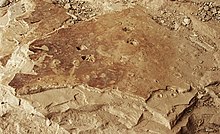|
Raindrop impressions Raindrop impressions are a geological feature characterized by small crater-like pits with slightly raised edges that are the result of the impact of raindrop impacts on soft sediment surfaces.[1] Sedimentary structures with similar appearance have been found. They can be considered a type of fossil, but their significance and authenticity has been questioned.[2] Description  Raindrop impressions are only a few millimeters thick and less than 1 centimeter in diameter.[3] They can be preserved as widely scattered impressions or in close proximity to one another on the sediment surface.[1] Raindrop impressions can appear as small craters or as small raised bumps. If the sample has craters, the top of the sample is being viewed because the rain would have fallen onto it making indentations. If the sample has small raised bumps, the bottom of the sample is being viewed. In this case, the raindrop impressions were created in the sediment, which was then followed by more sediment which filled the impressions, creating, what appear to be, raised bumps on the bottom of the upper layer. Fossilized raindrop impressions can help scientists determine historical atmospheric pressure.[4] Other explanations for the featuresRainfall is not the only explanation for the geological feature, and not all "raindrop impressions" are considered to have formed due to the impact of raindrops. Arguments against a raindrop origin include:
In order for raindrop impressions to be preserved in the rock record, the impression would have to have occurred towards the end of a rain shower. The decreased number of impacts at this time accounts for the scattered patterns of the impressions, and the specific saturation of the sediment allows for preservation. It is difficult to differentiate between actual impressions made by rain and other sources such as gas bubbles escaping, or dripping from another surface, because the structures that are preserved have the same characteristics. See alsoReferences
|